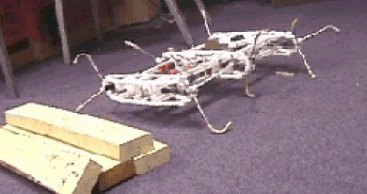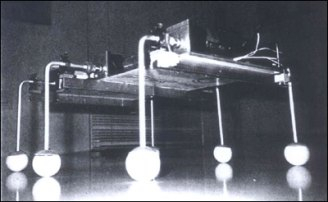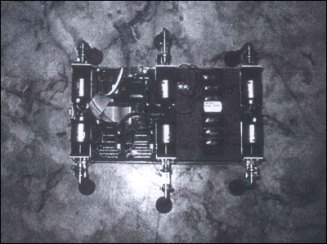Whegs™ I
The Whegs™ series robots utilize a method of locomotion that combines the advantages of wheels and legs (wheel-legs). Wheels are relatively simple, and allow a vehicle to to move over terrain quickly. Legs allow robots to climb obstacles that are higher than what a wheeled vehicle would be able to climb over.
PROLERO (PROtotype of LEgged ROver) preceded Whegs™. It was designed in 1996 by A. Martin Alvarez at the European Space Agency. It uses 6 drive motors (one for each leg). Each leg consists of a spoke, which rotates in a circular motion. Pictures of PROLERO can be seen below:
A drawing of the PROLERO rover concept can be found in the following reference:
“Walking Robots for Planetary Exploration Missions”, A. Martin-Alvarez, W. de Peuter, J.Hillebrand, P.Putz, A.Matthyssen, J.F. de Weerd, WAC’96, Second World Automation Congress, May 27-30, 1996, Montpellier, France.
RHex (2000) also preceded Whegs™ and was a source of inspiration for Whegs™. It also uses a total of 6 motors and spoke-like legs. During the swing phase of walking, its feet rapidly rotate to return to the stance phase, when the feet rotate much more slowly.
In contrast, Whegs™ uses just one motor for propulsion, which gives them the advantage of being able to supply any leg with the maximum power available onboard the vehicle, if it is the only leg that is able to get a foothold. When individual legs are driven by individual motors, each motor must be powerful enough for the worst-case scenario. By using a single drive motor, the same amount of torque can be supplied, with a lot less weight in motors.
The drive motor in a Whegs™ robot runs at a constant speed, instead of accelerating and decelerating its legs during each walking cycle like RHex does. Whegs™ runs quickly and climbs barriers and stairs with the same multifunctional legs, whereas RHex requires different legs for different tasks.



